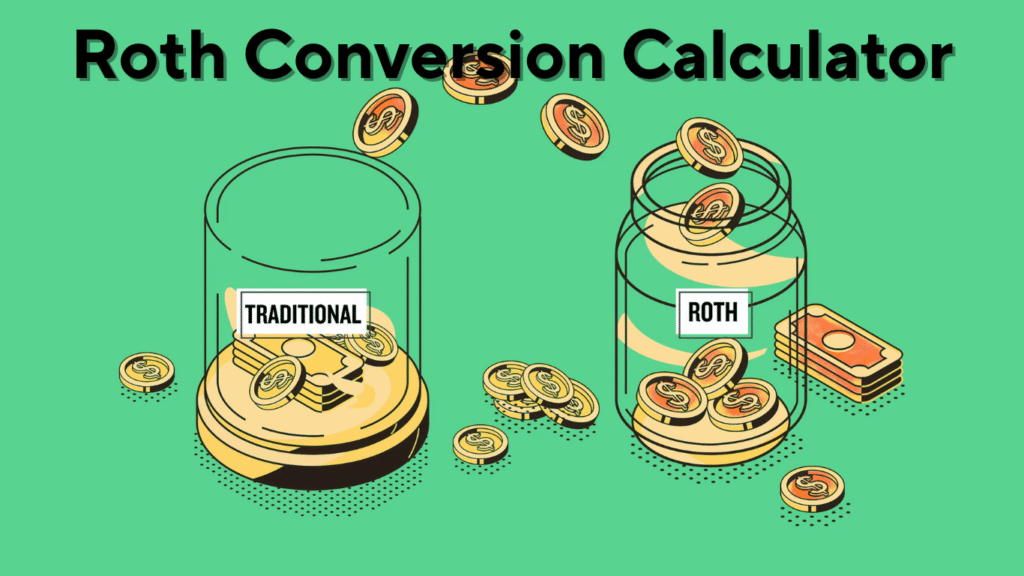Roth Conversion Calculator
Determine if converting your traditional IRA to a Roth IRA makes financial sense for your situation.
Input Your Details
Results
Traditional IRA Value
$0
Roth IRA Value
$0
After-Tax Difference
$0
Comparison Over Time
Recommendation
How Roth Conversions Work
A Roth IRA conversion is when you move money from a traditional IRA (or other qualified retirement account) into a Roth IRA. This can be beneficial if you expect to be in a higher tax bracket during retirement.
Key Considerations:
- You’ll pay taxes on the converted amount in the year of conversion
- Future withdrawals from the Roth IRA will be tax-free
- Roth IRAs have no required minimum distributions (RMDs)
- You can withdraw contributions (but not earnings) at any time without penalty
When Conversion Makes Sense:
- Your current tax rate is lower than your expected retirement tax rate
- You have funds outside the IRA to pay the conversion taxes
- You want to leave tax-free assets to heirs
- You want to reduce future RMDs that could push you into a higher tax bracket
What is a Roth Conversion?
A Roth conversion refers to the process of transferring funds from a Traditional IRA or 401(k) into a Roth IRA. When you do this, you pay taxes on the converted amount now, but in exchange, your money grows tax-free, and you can withdraw it tax-free in retirement.
Why Use a Roth Conversion Calculator?
A Roth Conversion Calculator is a financial planning tool that helps you:
- Estimate taxes owed on your conversion
- Compare different conversion scenarios
- Understand break-even points for tax savings
- Forecast long-term Roth IRA growth
- Evaluate the benefits of partial vs. full conversions
This tool is essential for anyone considering a conversion strategy, especially if you’re planning for early retirement or expect to be in a higher tax bracket in the future.
According to the IRS Roth IRA conversion rules, you’ll need to pay ordinary income tax on the converted amount. However, once inside the Roth IRA, your investments grow tax-free.
Key Benefits of a Roth IRA Conversion
✅ Tax-Free Growth and Withdrawals
Unlike traditional accounts, Roth IRAs offer tax-free withdrawals in retirement, including both contributions and earnings.
✅ No Required Minimum Distributions (RMDs)
Traditional IRAs require RMDs starting at age 73, but Roth IRAs don’t, allowing more control over your retirement income.
✅ Estate Planning Advantage
Roth IRAs can be passed to heirs with minimal tax consequences, making them a useful legacy tool.
✅ Potential for Tax Diversification
Having both Roth and Traditional retirement accounts allows more flexibility in managing taxable income during retirement.
How the Roth Conversion Calculator Works
Our Roth Conversion Calculator uses key inputs to give you a comprehensive outlook:
🔹 Inputs:
- Current Traditional IRA or 401(k) balance
- Your current age
- Annual income and tax filing status
- Expected retirement age
- Estimated investment growth rate
- Federal and state income tax rates
🔹 Outputs:
- Taxes due on the converted amount
- Future value of Roth IRA at retirement
- Tax savings from Roth withdrawals
- Break-even timeline for conversion
- Comparison of Roth vs. Traditional outcomes
Who Should Consider Using the Calculator?
This tool is ideal for:
- High-income earners who anticipate higher future tax rates
- Young investors with decades before retirement
- Pre-retirees planning for early withdrawals
- Estate planners aiming to reduce heirs’ tax liabilities
- Anyone wanting more control over future tax burdens
Things to Consider Before Converting
- Current Tax Bracket: A higher bracket means more taxes now, so consider converting during low-income years.
- Conversion Timing: Spreading conversions over multiple years can help manage tax impacts.
- Availability of Cash to Pay Taxes: Paying the tax bill from outside the IRA avoids reducing your retirement savings.
- Impact on Medicare Premiums and Tax Credits: A large conversion might trigger higher premiums or loss of tax benefits.
Partial vs. Full Roth Conversions
You don’t have to convert your entire IRA at once. Partial conversions allow for tax-efficient strategies over several years.
Example:
Converting $20,000 each year for 5 years may keep you in a lower tax bracket compared to converting $100,000 all at once.
Final Thoughts
A Roth IRA conversion can be a powerful retirement planning strategy—but only if it fits your financial situation. Our Roth Conversion Calculator helps simplify the decision-making process by showing the short- and long-term financial impacts.
🔍 Try our Roth Conversion Calculator now and make smarter, tax-efficient retirement moves!
FAQs:
❓ Is a Roth conversion taxable?
Yes. You must pay ordinary income tax on the amount you convert.
❓ Can I undo a Roth conversion?
No. Since the 2018 tax law changes, Roth conversions are permanent.
❓ When should I convert to a Roth IRA?
The best time is typically during low-income years or before RMDs begin.

